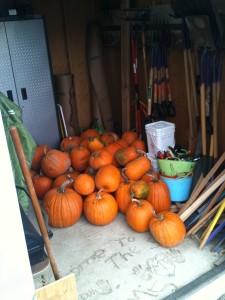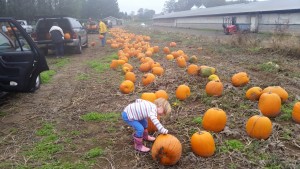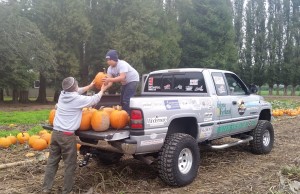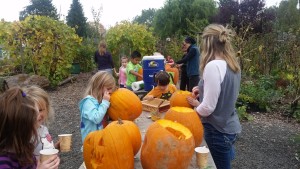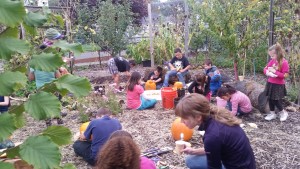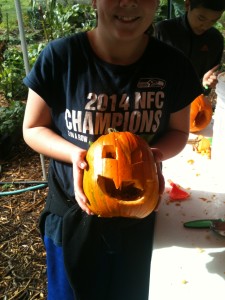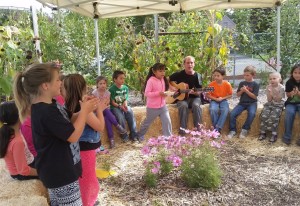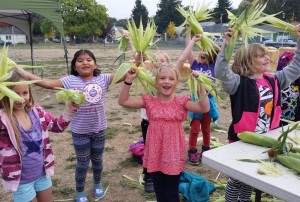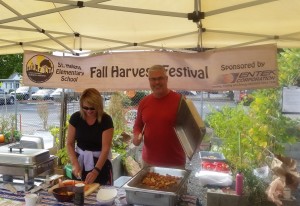Check out this short video to learn more about Lower Columbia School Gardens: how it all started, and how we engage kids and families.
Yearly Archives: 2015
Seed companies make it possible for School Gardens to grow
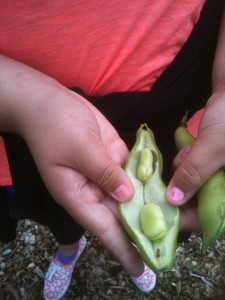
Over the last year, we have been proud to help students plant 102,000 square feet of space in more than fourteen School Gardens. That’s a lot of growing space! When you’re dedicated to starting your veggies from seed, that much garden space means having plenty of quality seeds around.
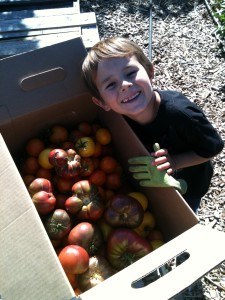
We are immensely grateful for the companies who provided us with seeds this past year. We’re still working on the tally, but the amount of fresh produce grown in 2015 far exceeds the amount we were able to grow the previous year.
It is with admiration for the beautiful work they do and their generous giving that we thank:
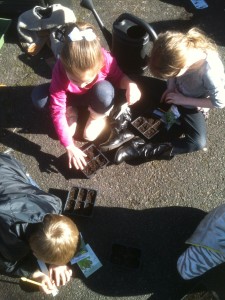
Adaptive Seeds
Baker Creek Heirloom Seeds
Botanical Interests
High Mowing Seeds
Irish Eyes Garden Seeds
Peaceful Valley Seeds
Renee’s Garden Seeds
Seeds for Our Planet
Siskiyou Seeds
Territorial Seed Company
Tsugawa Nursery
Turtle Tree Seed
Uprising Seeds
Van der Salm Bulb Farm
Xerces Society Pollinator Habitat signs help make School Gardens a haven for pollinators
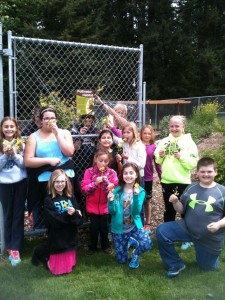
Earlier this year, The Xerces Society of Portland generously donated Pollinator Habitat signs for all of our School Gardens. Posting these signs with students has started a number of profound conversations about the vital role that pollinators play in our gardens and our food supply.
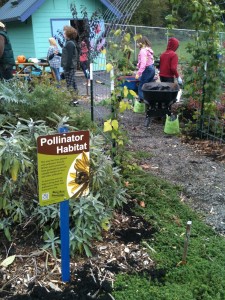
For some students, these conversations have made them less fearful of insects that they thought were only made for stinging, and others have become more interested in paying attention to the small differences between various kinds of pollinators. The signs have also been a good reminder to simply be aware of the helpers in our gardens that are not always easy to see.
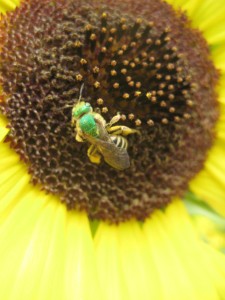
Students have helped to create a great deal of pollinator habitat in school gardens by planting many flowers and other plants crucial to their survival.
Thank you, Xerces Society!
To help protect an essential part of our environment, take the Pollinator Pledge and order a Pollinator Habitat sign for your own garden.

–
$250k Kaiser grant expands School Gardens for Longview and Kelso
FOR IMMEDIATE RELEASE
December 1, 2015
Kaiser Permanente Northwest Awards Grant to Cowlitz County Health Department
Cowlitz County Health Department’s (CCHD) Office of Healthy Communities received $250,000 over
the next three years to partner with Lower Columbia School Gardens and the Longview and Kelso
School Districts to increase fruit and vegetable consumption for school-age children. This collaborative
project will expand access to school garden activities and curricula for children and their families.
This grant will allow Lower Columbia School Gardens to expand their capacity to serve more children in
our county through their 14 school-based gardens, and to integrate their programs and activities more
fully into the school environment. Longview and Kelso School Districts will be able to fully utilize school
gardens as an educational and community resource.
“We are grateful to Kaiser Permanente for this opportunity to engage even more kids in our school
gardens. We know that school gardens work; kids are more likely to eat and enjoy fruit and vegetables
they grow themselves, and they get excited about healthy cooking and eating as they learn about
where real food comes from and how it’s grown. We see that reality in our work every day, and this
new partnership will allow us to share that experience with more children, teachers and families in our
community,” says Ian Thompson, Executive Director of Lower Columbia School Gardens.
Kaiser Permanente Northwest is dedicated to improving the health of individuals and the communities
they serve. Specifically, their work is focused on connecting low-income people to health care,
educating children and families about healthy eating and active living, creating and sharing
groundbreaking research, strengthening health safety nets in communities, and supporting their employees’ community engagement.
CCHD provides broad-spectrum public health services to Cowlitz County residents aimed at improving
and protecting the health and well-being of individuals of all ages. To contact the Health Department,
please call 360-414-5599.
We Are Hiring! Full-time Garden Coordinator
Job Announcement, November 2015
Garden Coordinator
Lower Columbia School Gardens
Lower Columbia School Gardens (LCSG) is a non-profit organization in Cowlitz County that helps schools start and sustain dynamic, thriving garden programs. LCSG has helped create and sustain 13 school gardens in Southwest Washington, and engages over 3,000 students each year in hands-on, garden based learning activities. Find out more on our website, http://www.lowercolumbiaschoolgardens.org/.
The Garden Coordinator facilitates a wide variety of hands-on learning for children in multiple school gardens by leading a wide variety of garden-based learning activities, including teaching garden and cooking lessons tied to curriculum standards. The Garden Coordinator promotes the LCSG mission with our partners, stakeholders and the general public. This is a full-time, 40 hour per week position with occasional evening and weekend hours. We are seeking a kind, creative, energetic person who is passionate about real food, kids, plants, and soil.
Essential Functions:
- Develop and facilitate garden-based lessons and activities for elementary and middle school children including cooking lessons, arts and crafts activities and lessons tied to curriculum standards
- Recruit, coordinate and retain LCSG volunteers
- Integrate garden-based curricula into existing educational settings
- Create and share garden resources for teachers, children and garden volunteers such as planting guides, lesson plans and volunteer training resources
- Promote LCSG through marketing, social media, community outreach, teacher and parent engagement
- Coordinate LCSG events such as fundraisers, volunteer appreciation events, harvest festivals, produce sales, after-school garden clubs, community outreach and others
- Participate in program evaluation and research
- Collect and maintain data on volunteer and student participation and other metrics
- Participate in fundraising and grant writing to support the on-going work of LCSG
- Perform garden maintenance tasks—watering, weeding, mulching, soil and compost, cleaning and organizing garden classrooms, sheds and outdoor spaces
- Maintain a working knowledge of significant developments and trends in the school garden field
Qualifications:
- High School diploma
- Bachelor’s degree in relevant field preferred
- 2 years in environmental education or children’s program development, or equivalent experience and skills.
- Demonstrated ability to develop successful outdoor education programs, and facilitate hands-on learning and dynamic programming for elementary through middle school children
- Strong interpersonal skills, leadership and teamwork
- Excellent writing and communication skills
- Ability to work independently
- Experience with volunteer management
- Event planning and coordination experience
- Flexible, and ability to thrive in a fast-paced, sometimes unpredictable setting
- Proficiency with computers and basic software programs including google drive, Microsoft office
- Experience working with diverse populations and across disciplines (parents, teachers, school garden staff, community members, students)
- The ability to lift 25 lbs, operate garden tools (shovels, wheelbarrows, etc.), assist in construction (retaining walls, garden beds, trellises, sheds, etc.)
- Willingness to work in an outdoor environment in a variety of weather conditions
- Driver’s license and willingness to drive LCSG vehicles
Compensation: $12/hr.
Position is open until filled.
To apply for the position, please email a cover letter and resume to Ian Thompson, Executive Director for Lower Columbia School Gardens at ian@lcschoolgardens.org.
If you have questions, please contact Lauren Henricksen, henricksenl@co.cowlitz.wa.us or 360-414-5599 ext. 6434.
Download PDF: Garden Coordinator Job Description
October is for Harvest Festivals
The month of October was chock full of fun and goodness in the world of School Gardens. Most months of the year we delight in bringing real food and hands-on learning to hundreds of students on a weekly basis, but do you know what makes October so special?…
Harvest Festivals!
School Garden Harvest Festivals only happen once a year and call for “all hands on deck” to make them work. That means all of our School Garden volunteers, PTO members, staff, AmeriCorps members, parents and many of our board members show up to help. This year, our biggest year yet, nine elementary schools were able to participate.
That means every student at those 9 schools:
- made and drank fresh apple cider
- ground corn into cornmeal and wheat berries into flour
- ran the straw bale obstacle course
- shucked fresh corn
- ate roasted garden veggies and corn-on-the-cob
- listened and danced to live music
- learned more about real food
…all in their School Gardens.
Once again, none of these opportunities for our local students to experience real food and hands-on learning could happen without the support of so many people and businesses in this community. Thank you!
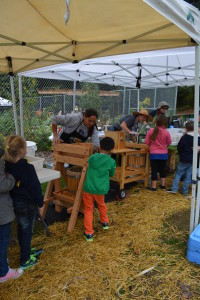
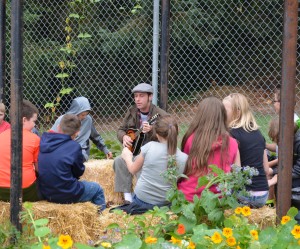
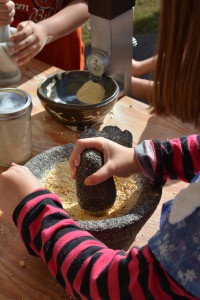
–
Farmer Randy donates 700 pumpkins to School Gardens
There were even-happier-than-usual kids in many Kelso and Longview School Gardens last week as After School Garden Clubs had the opportunity to carve locally-grown pumpkins. 700(!) pumpkins were donated by Woodland farmer Randy Behrendsen who was happy just to know they were going home with kids. Members of the LCSG board, LCSG staff and a slew of volunteers met in Woodland early on a Saturday to load pumpkins into trucks and deliver them back to school gardens in Longview and Kelso.
During the following week, kids in elementary and middle school gardens throughout the area got the chance to carve, decorate and take home their donated pumpkins. Students also enjoyed freshly roasted pumpkins seeds and made-from-scratch hot cocoa with their pumpkin carving.
–
Fall 2015 Fundraiser
Thanks to all who attended our Fall Fundraiser. If you couldn’t come this time, donations and contributions are always welcome. Please check out our donation page.

Entek generously sponsors St. Helens Harvest Festival
Every student at St. Helens had a blast on October 6 and learned a lot about real food at the same time. The Harvest Festival at St. Helens was generously sponsored by Entek. Many thanks to all our volunteers who worked so hard to make it a wonderful day for all.
Email info@lcschoolgardens.org to get in on similar events every year during the month of October.
–
Growing your own garlic
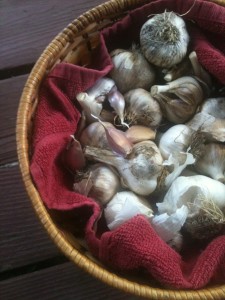
Garlic is easy to grow Garlic is a simple and wonderful thing to grow in your own garden. The bulbs and cloves are a welcome and healthful ingredient in many dishes.
Softneck vs. hardneck garlic Softneck garlic is what you’ll typically find in grocery stores, mainly because it can be stored for such a long time without sprouting. Softneck is also great for making garlic braids and has a relatively mild, simple flavor. Hardneck varieties of garlic are closer to wild garlic, with complex flavors. The skins or wrappers of many of these varieties tend to slip off smoothly, so they’re sometimes preferred for using in the kitchen. If you plant hardneck garlic you’ll also get to enjoy a garlic scape harvest. Most hardneck varieties will store for 6 – 10 months.
Amend soil in mid to late-Sept and plant any time during Oct in loose, rich soil In our corner of the country (the Pacific NW), garlic is usually planted during the month of October, hopefully giving the cloves enough time to grow some early roots before the ground freezes. This member of the Allium family appreciates soil that has been amended a few weeks in advance with a well-balanced organic fertilizer or compost. Plan to do the soil amending in mid to late September and then once your garlic has been planted it is best to cover over the soil with mulch – either straw or leaves.
Plant cloves 5 – 9 inches apart • Choose the biggest cloves for planting and save the smallest for cooking Plant each clove 5 – 9 inches apart, no matter how you lay out your rows or beds. Break bulbs apart into separate cloves just prior to planting and plant the root end down (usually this means the pointy side goes up), about two inches deep. Stick to planting only the larger cloves since smaller cloves will yield smaller bulbs, and use the smaller cloves for eating right away.
During Spring: Fertilize once and water regularly In the Spring when garlic plants are experiencing most of their vegetative growth, water regularly like any garden green (when it’s not raining, that is). Organic Nitrogen fertilizer should be applied at this stage of growth. When days become longer and the temperature starts to climb – typically in May – garlic is finished growing its green leaves and will begin to send energy downward to its bulb.
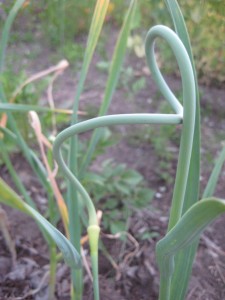
Cut garlic Scapes from hardneck garlic in May/June Hardneck varieties send up a flower stalk (AKA garlic scape, garlic curl, garlic bracelet, garlic spear) around May or June. Before the stalk begins to turn woody, uncoil, and stand up straight, the stalk should be harvested/cut from the plant about ½ inch above the top plant leaf. This helps direct the plant’s energy toward the bulb.
Harvest garlic crop in June/July when all but top four leaves have turned brown As harvest-time nears, the plants begin to dry and turn yellow/brown from the lowest leaf up and from the leaf tips downward, one at a time. Harvest when top four leaves are still mostly green. A spade, garden fork, or shovel is best for harvesting garlic but be careful to insert the tool far enough away from the plant that you don’t damage the garlic bulb.
Cure garlic for 3 – 4 weeks out of direct sunlight with plenty of air circulation Plants should be bundled in groups of 5 – 10 plants and hung inside out of directly sunlight with good air circulation. If fresh bulbs are left in direct sunlight for more than a few minutes they can actually sunburn or cook right in their skin! Bulbs are completely cured in three to four weeks in dry climates but fans may be necessary in other situations.
Store garlic in cool, dark location to prevent sprouting (do not store in fridge) Store your garlic as whole bulbs in a cool and dark place such as a basement or heated garage. Never store garlic in the fridge because it will sprout very quickly. Most garlic stores well at room temperature. Once planting season comes around again, start the same process over, using only the big cloves for planting and the rest for cooking.
Information adapted from Filaree Garlic Farm’s website.
For more information and details on garlic varieties, visit www.filareefarm.com

